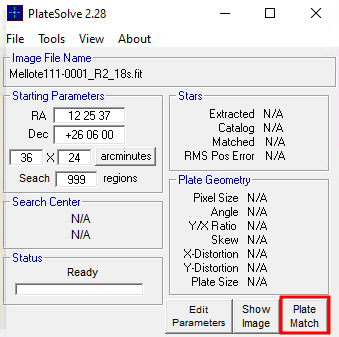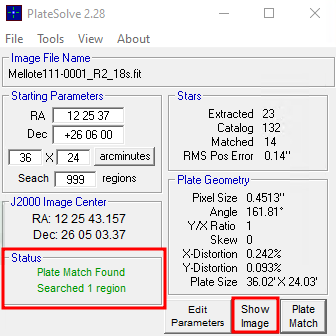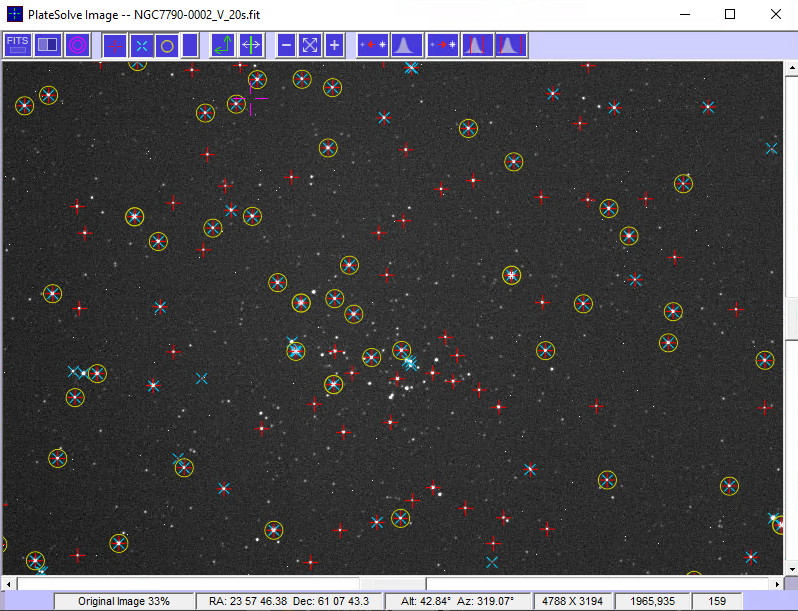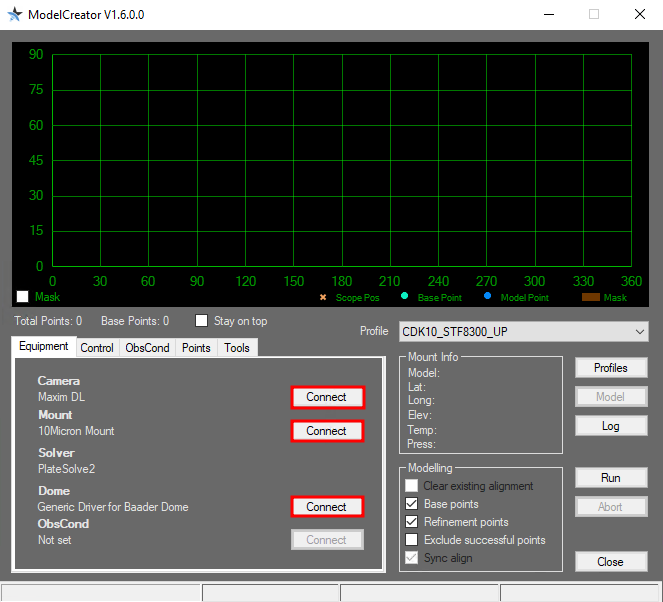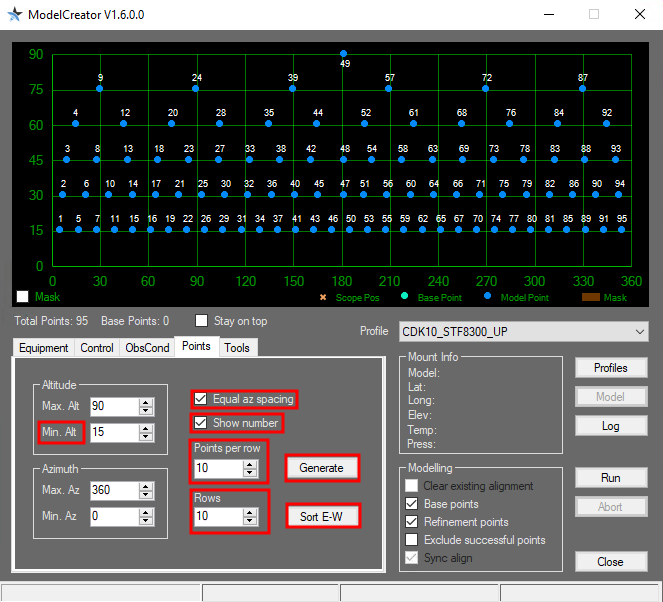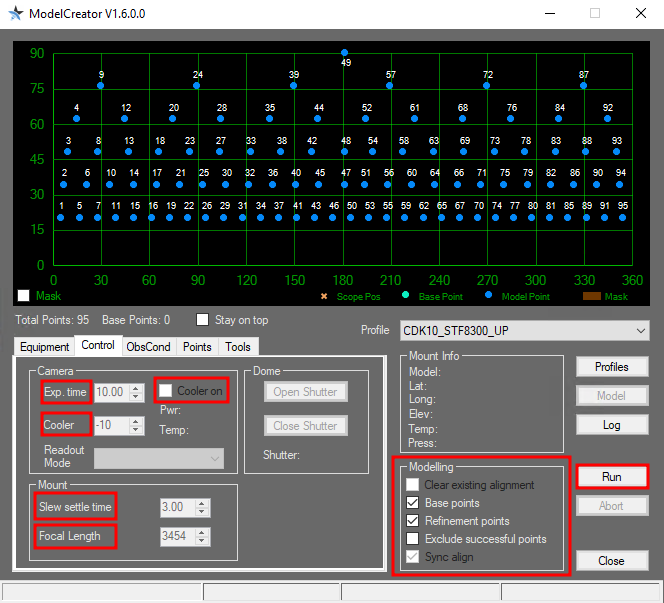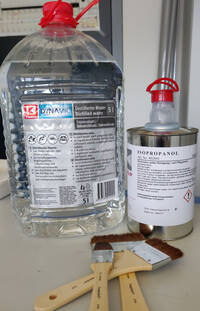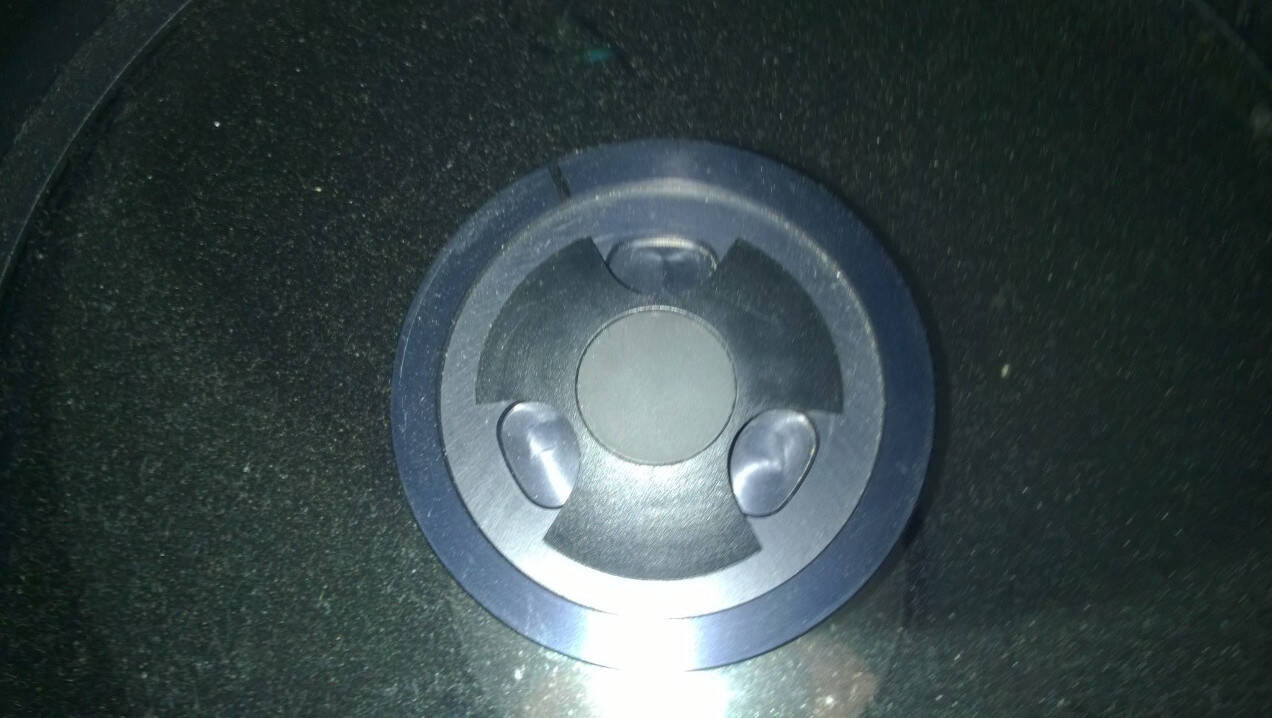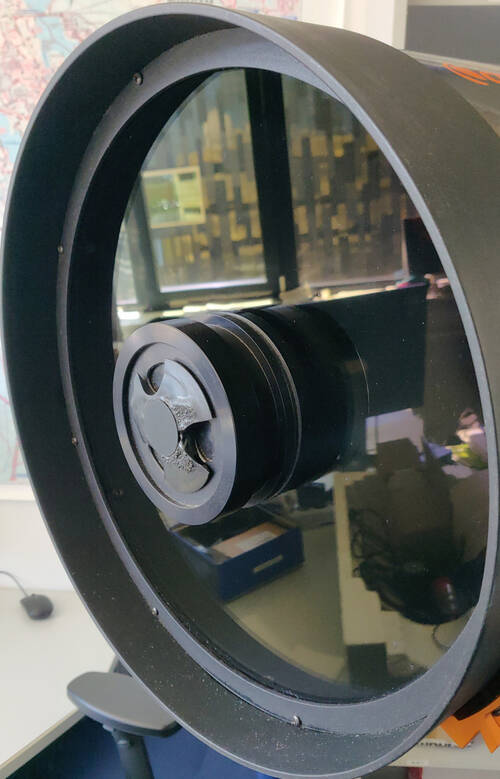This is an old revision of the document!

Telescope setup and maintenance
Setup of the mount
Using the mount directly
Alignment
The accuracy of the tracking can be improved with a good alignment. This procedure can gather information on possible errors in the azimuth and pole-height settings (correction suggestions for the hardware), to reduce errors in the alignment of the pole axis.
Alignment with 2 stars
MENU - Alignment - 2-Stars - ENTER
- select one star from the presented list and press ENTER
- select the second star from that list (it should have a large distance to the first in RA/DEC) and press ENTER
- the telescope changes its position and points to the first star
- the star should be in the center of the eyepiece, adjust the pointing with the N - S - E - W buttons as needed (use the eyepiece with the cross hair to easily estimate the center)
- once the star is centered, confirm with ENTER
- repeat the previous two steps with the second star
If the alignment has been successful, the hand terminal will show
Alignment complete
Refining the alignment
It is advisable to refine the alignment with further stars. Select this option in the hand terminal
MENU - Alignment - Refine 2-Stars - ENTER
- as before, the hand terminal will display a list of stars
- select one star to which the telescope will move
- center the star in the eyepiece and confirm with ENTER
- the hand terminal will then show:
Alignment refined
- repeat this procedure until an alignment with 10 stars has been completed
- to improve the accuracy all stars should be spread across the whole sky
There are further methods to change/improve the alignment that are documented in the manual of the GM 4000 QCI, which can be found in room 2.009.
Saving, restoring, and deleting of an alignment
Once a good alignment has been reached, it is recommend to save it:
MENU - Alignment - Align Database - Save Model
The telescope will then swing to the so called “Home Search” position and saves the alignment. This alignment can then be restored after an alignment loss with:
MENU - Alignment - Align Database - Load Model
The telescope will then once again swing to the “Home Search” position and load the previously saved data.
It can be necessary to delete a (bad) alignment, e.g. if it only proves to be useless after it has been saved. An alignment can be deleted with:
MENU - Alignment - Align Database - Delete Model
Alternatively one can reset the mount:
MENU - Alignment - Reset at Home
In doing so, the alignment will be deleted and the mount restored to the factory settings. Only use this option with caution!
Alignment Information
Information on the current alignment can be found at:
MENU - Alignment - Align info
With this option, the mount among others gives information on how the orientation of the pole axis can be improved. The terminal will display something like:
To center pol ax move .07 Rt 0.05 Up
Using the OMS
Creating a pointing model
The advantage of setting up the mount via the OMS is that a much more precise pointing model can be created, since not only a few stars are used, but up to 100 star fields distributed over the whole sky can be utilized. The exact position of these star fields is determined automatically with the help of the so-called Plate Solving.
We use the software ModelCreator.
The most important settings in the Equipment tab such as Camera, Mount, Solver and Dome should already be preset. These settings are stored as profiles. The predefined profiles can be selected from the Profile drop-down menu. By clicking on Profiles the profiles can be edited and also new ones can be created. By clicking on the Connect buttons at Camera, Mount and Dome the corresponding devices can be connected to the ModelCreator. In the case of the camera, it must be ensured that the camera is connected beforehand to MaxIm DL because ModelCreator fetches the data from there.
Next you should set the points where ModelCreator will create images of the sky. You should set a minimum height above the horizon (Min Alt), because points too close to the horizon do not make sense due to the long way the light travels through the atmosphere. It has been proven that at least a minimum altitude of 15° is necessary. Furthermore, it has turned out to be useful to activate the option Equal az spacing in order to achieve an optimized distribution of the points. If you also activate the option Show number the order in which the points are processed is also displayed. Afterwards you can click on Generate to generate the points. After that you can click on Sort-EW to sort the points from east to west. This significantly reduces the overall slewing time required by the mount. For our final pointing model we usually use up to 100 points. For this we usually set Points per row and Rows to 10 each. Additionally 3 base points can be selected. Click on the corresponding points with the mouse.
It has proven useful to increase the exposure time for points close to the horizon, because there the air mass increases significantly. Otherwise not enough objects can be identified. For points in the Milky Way, on the other hand, it can happen that no solution can be achieved by plate solving, because there seem to be too many stars in this area. In this case, it might be helpful to reduce the exposure time. The exposure time can be adjusted via the Control tab. Here you should also set a Slew settle time of 3s and the focal length of the telescope (Focal Length).
Afterwards the calibration can be started by clicking Run. Before that, make sure that the options Clear exsisting alignment and Sync align are activated. Then ModelCreator moves the mount to the first point, takes an image, starts PlateSolve, searches for the exact coordinates of the star field, uses this solution to improve the pointing model and continues with the next point.
PlateSolve identifies the stars in the respective star field and compares their position with star catalogs. Starting from the coordinates provided by the telescope, a spiral outward search is performed. In the example in the center below, the first step of the iteration was already successful and the star field was successfully identified. If the pointing model is not yet as good as in this example, which is usually the case when a completely new pointing model is created, it may take several iterations until the star field is identified. If after 99 iterations the star field has not been found, the iteration is aborted and ModelCreator moves on to the next pointing without any changes.
Analyzing a pointing model
Will follow soon…
A-PEC
The Periodic Error Correction (PEC) can help to improve the tracking accuracy of the mounting by accounting for periodic errors of the worm gear. This error usually has a period of approx. 3 min 20 sec (3.3 minutes), while the PEC can correct for shorter periods, too. The error of the worm gear is usually irrelevant as long as the observations are only carried out with an eyepiece – in case longer observations are taken with CCDs, the corrections of this error are getting important.
The PEC has to be calibrated before it can operate properly. For this purpose, the mount needs detailed information on the deviations from the ideal tracking behavior. One possibility to achieve this is by centering a bright star in an eyepiece and following its motions with the hand terminal (the N - S - E - W buttons) for a while. A more sophisticated option is based on the autoguide functionality of our CCD cameras, as the precision is higher this way. Start the PEC calibration on the hand terminal with:
Drive -> A-PEC control -> A-PEC Training
In the next step choose the time period during which the PEC shall be “trained”: 15, 30, or 60 minutes. The longer the training is, the better is the result of the PEC. After the training has been completed the corrections are calculated and the PEC is automatically activated.
Pole height adjustment
- will follow…
Schmidt-Cassegrain telescopes (C14, C11, & C8)
Check and improve the collimation
Check
- the telescope should have ambient temperature
- drive to a bright star in zenith (Polaris can be used, too)
- use the 25mm ocular (or the webcam)
- defocus the star so it takes about one sixth of the FoV (field of view) and gets a doughnut shape
- if the shadow of the secondary mirror (the inner part of the doughnut/defoussed star) is off-centered, the collimation of the telescope is erroneous
Improvement
- move the star (using the N - E - S - W buttons) in the direction to which the shadow is off-centered until the edge of the FoV is reached
- turn the three screws on the backside of the secondary mirror (see Figure below) until the star is again in the center of the FoV. To achieve that:
- tighten the screw(s) in the direction of the offset
- loosen the other(s)
- repeat this procedure until the shadow is centered on the defocused star
- repeat with eyepieces of higher magnification (note: in 6mm eyepieces the star is kept focused and the correction is carried out in relation to a (very) thin diffraction ring)
ATTENTION: ONLY VERY MARGINAL CORRECTIONS NEED TO BE APPLIED TO THE SCREWS!
Pflege der Schmidtplatte
Nicht anfassen und immer schön nach der Beobachtung den Deckel auf das Teleskop machen damit sich nicht unnötig viel Staub auf der Schmidtplatte sammelt! Besonders im Herbst und Winter bietet es sich an die Taukappe zu verwenden, um unnötige Kondensation vorzubeugen.
Reinigung
Von Zeit zu Zeit müssen die Schmidtplatten unsere Schmidt-Cassegrain-Teleskope gereinigt werden. Dies ist ein diffiziler Prozess, da man hierbei um jeden Preis vermindern muss, dass die Schidtplatte z.B. durch Kratzer beschädigt wird.
Die folgenden Materialien werden benötigt:
- Destilliertes Wasser
- Alkohol - Isopropanol
- Kosmetiktücher oder Zellstofftaschentücher, die man in die einzelnen Lagen teilen kann
- Sehr wichtig: Die Tücher dürfen keine Lotionen, Geruchsstoffe oder Sonstiges in diese Richtung enthalten
- Wattebäusche
- Kamelhaarpinzel
- Mikrofasertuch
- Reines Spülmittel ohne weitere Zusätze wie z.B. Pflegestoffe für die Hände
- Optional: Kleiner Blasebalg oder Druckluftflasche ohne Treibmittel
Vorgehensweise:
- Als erstes sollte man das Teleskop in eine Position bringen, in der es möglichst ein bisschen in Richtung Boden schaut. Auf diese Weise kann verhindert werden, dass Reinigungsflüssigkeit in das Teleskop läuft.
- Loser Staub kann mittels des Blasebalg oder der Druckluftflasche entfernt werden. Hierbei muss darauf geachtet werden, dass in einem möglichst flachen Winkel auf die Schmidtplatte geblasen wird, um die Verschmutzungen von der Schmidtplatte zu blasen und diese nicht noch weiter auf die Schmidtplatte zu drücken. Mit einer Druckluftflasche sollte man zuerst probe Sprühstöße machen, sodass man ein Gefühl dafür bekommt, wie viel Luft herauskommt und um sicher zugehen, dass sich durch den Einsatz nicht doch irgendwelche zusätzlichen Ablagerungen auf der Schmidtplatte bilden können.
- Als nächstes können weitere Verunreinigungen mittels des Kamelhaarpinzels entfernt werden.
- Als Reinigungsflüssigkeit bietet sich eine Mischung aus destillierten Wasser und Isopropanol im Verhältnis 50:50 oder 50:60 an. Des Weiteren kann für stark verschmutzte Oberflächen auch noch ein wenig Spülmittel hinzugehen werden. Auf 500ml Reinigungsflüssigkeit sollte nicht mehr als 1 Tropfen hinzugeben werden, da sonst Rückstände auf der Schmidtplatte verbleiben können.
- Ist die Schmidtplatte stark mit klebrigen Pollen belegt, biete es sich an, den Belag vorsichtig einzuweichen. Hierfür mit dem Pinsel vorsichtig ein wenig Reinigungsflüsigkeit auftragen. Hierbei möglichst in Quadraten arbeiten.
- Mit befeuchteten Wattebäuschen zuerst die starken Verschmutzungen entfernen. Hierfür immer in geraden Linien am besten von innen nach außen streichen und den Wattebausch dabei rotieren, damit man mit den am Wattebausch haftenden Verunreinigungen nicht über die Oberfläche reibt. Nur mit ganz wenig Druck arbeiten und niemals in Kreisen reiben.
- Anschließend die verbliebenen Verunreinigungen mit befeuchteten Kosmetiktüchern entfernen. Hierfür wieder in geraden Linien von innen nach außen mit leichtem Druck streichen und dabei vermeiden, dass der aufgenommene Dreck an der Schmidtplatte reibt.
- Die Reinigungsflüssigkeit sollte abtrocknen ohne Rückstände zu hinterlassen. Ist dies nicht der Fall, sollte der Reinigungsvorgang noch einmal mit einer neu angesetzten Reinigungslösung ohne Spülmittel wiederholt werden.
Corrected Dall-Kirkham-Teleskop - CDK20
Kollimation
- kommt noch …
Reinigung der Spiegel
Für die Reinigung des Spiegels müssen im Prinzip die gleichen Schritte durchgeführt werden wie für die Reinigung der Schmidtplatten bei den Schmidt-Cassegrain-Teleskopen mit folgenden Ausnahmen:
Zusätzlich benötigte Materialien:
- Papierhandtücher
Änderungen bei der Vorgehensweise:
- Bei Reinigung des Hauptspiegels:
- Zusätzlich sollte man einige Papierhandtücher in die Kohlefaserhülle um den Spiegel legen, sodass überflüssige Reinigungsflüssigkeit von diesen aufgenommen wird und nicht hinter den Spielgel läuft und dort z.B. in Kontakt mit der dort verbauten Elektronik kommt. Die Papierhandtücher dürfen nicht in Kontakt mit dem Spiegel kommen.
- Bei Reinigung des Sekundärspiegels:
- Das Teleskop sollte in diesem Fall ein paar Grad über den Horizont schauen.
Problems and their solution
We also have a compilation of problem solutions to known error sources.
